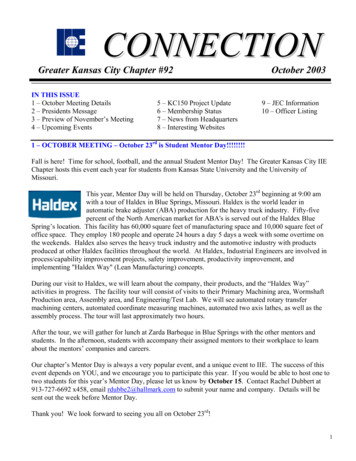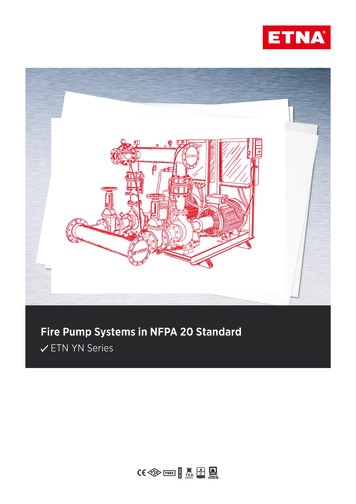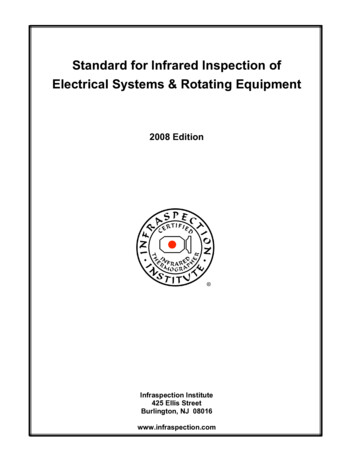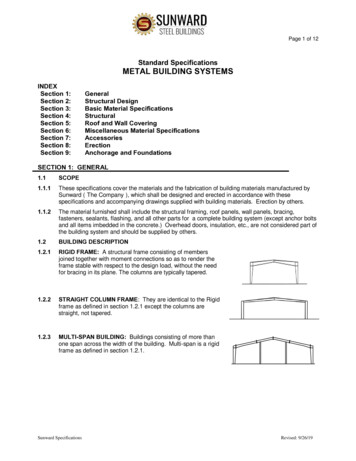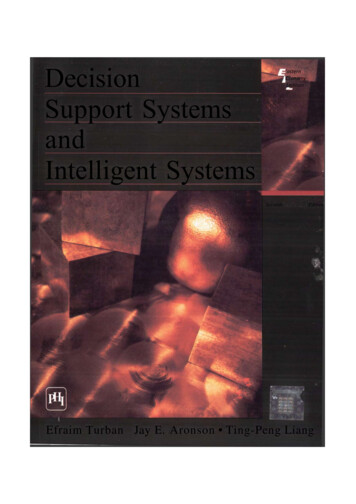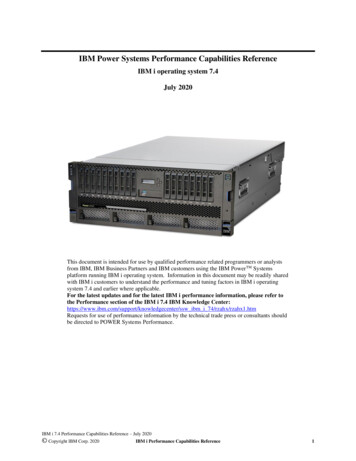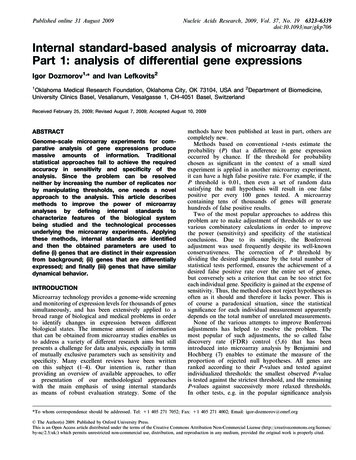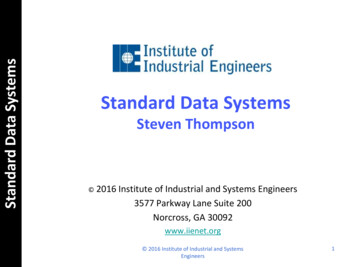
Transcription
Standard Data SystemsStandard Data SystemsSteven Thompson 2016 Institute of Industrial and Systems Engineers3577 Parkway Lane Suite 200Norcross, GA 30092www.iienet.org 2016 Institute of Industrial and SystemsEngineers1
Standard Data SystemsObjectives Define standard data systemsDetermine advantages and disadvantages ofstandard data systemsApply analytical tools to develop standard datamodelsDevelop standard data modelsEvaluate standard data models 2016 Institute of Industrial and Systems Engineers2
Standard Data SystemsWork Measurement DefinedWork measurement is a systematic procedure that isemployed to determine the time required to performwork tasks using the “best” method.This time is called the Standard Time. 2016 Institute of Industrial and Systems Engineers3
Standard Data SystemsMethods of Measuring WorkEstimation Basic Historical Data SWAGDirect Measurement Time Study Work Sampling PhysiologicalSynthesis Elemental Standard Data (Macro) Predetermined Times (Micro) 2016 Institute of Industrial and Systems Engineers4
Standard Data SystemsMicroscopic Standard Data(Pre-determined time systems) (PTS) Predetermined leveled times are established forbasic body motions, such as reach, move, turn,grasp, position, release, disengage, and applypressure. The analyst may obtain them frompublished standards in tabular or electronicforms, or the firm may develop its own. 2016 Institute of Industrial and Systems Engineers5
Standard Data SystemsPredetermined Time Systems Continued To use predetermined leveled times, the analystmust:–––Clearly define and document the work design,including the best design of the work place, tools,tasks, and subtasks.Select and document the source of thepredetermined leveled times.Identify and document the basic body motionsinvolved in performing each subtask 2016 Institute of Industrial and Systems Engineers6
Standard Data SystemsPredetermined Time Systems Continued Assign times to the body motions required tocomplete each subtask and total assigned timesto develop a leveled time for the subtask.– Documentation should demonstrate that theaccuracy of the original data base has not beencompromised in application or standarddevelopment.Total subtask times to develop a leveled time forthe entire task. 2016 Institute of Industrial and Systems Engineers7
Standard Data SystemsSample PTS Systems MTMMOSTMODAPTS 2016 Institute of Industrial and Systems Engineers8
Standard Data SystemsMethods-Time Measurement (MTM) A procedure that analyses manual operations ormethods into basic motions needed to performit, and assigns each a pre-determined time basedon the motion and environmental conditions 2016 Institute of Industrial and Systems Engineers9
Standard Data SystemsTime Measurement Units (TMU) 1 TMU 0.00001 hour1 TMU 0.0006 min1 TMU 0.036 sec1 hour 100,000 TMU1 min 1667 TMU1 sec 27.8 TMU 2016 Institute of Industrial and Systems Engineers10
Standard Data SystemsMaynard Operation Sequence Technique(MOST) Developed in 1980 by Zjell ZandinEstablishes standards at least 5 times faster thanMTM-1, w/little if any sacrifice in accuracyConcentrates on the movements of objects 2016 Institute of Industrial and Systems Engineers11
Standard Data SystemsMOST Procedure Watch job/taskDetermine sequence(s) to useDetermine index valuesAdd index values to determine TMUMultiply TMU by 10Convert TMU to seconds, minutes, hours 2016 Institute of Industrial and Systems Engineers12
Standard Data SystemsModapts MODAPTS divides manual work into threeclasses:Transports, Terminal, and other motions.– When used for manual assembly work, transportsand terminal motions take virtually all of the tasktime.In each case, the number represents a MOD, or.129 seconds. 2016 Institute of Industrial and Systems Engineers13
Standard Data SystemsStandard Data Systems(SDS) Standard data systems (or elemental standarddata) are developed for groups of motions thatare commonly performed together, such asdrilling a hole or painting a square foot of surfacearea. Standard time data can be developed usingtime studies or predetermined leveled times.After development, the analyst can use thestandard time data instead of developing anestimate for the group of motions each time theyoccur. 2016 Institute of Industrial and Systems Engineers14
Standard Data SystemsStandard Data Systems There are times when it is not practical to setstandards with any direct measurementprocedure.–––High volume of different partsLow production runRapid changeover 2016 Institute of Industrial and Systems Engineers15
Standard Data SystemsStandard DataStandard data expresses the relationship betweencertain pertinent characteristics of a task and thetime required to perform that task, in a form thatpermits synthesis of the latter from the former.Rather than determine the standard time for each job onthe basis of an individual study, standard times from anumber of related jobs may be organized into a database from which the standard times for related jobs maybe constructed or synthesized.Marvin Mundel 2016 Institute of Industrial and Systems Engineers16
Standard Data SystemsStandard Data Applications Jobs similar in natureHighly repetitive workJobs that have multiple standards due tocombinations of variablesLong cycle time jobs that have repetitive elementswithin the long cyclesIndirect labor 2016 Institute of Industrial and Systems Engineers17
Standard Data SystemsStandard Data System Defined The normal time values for the work elements areusually compiled from previous direct time studies(DTS).Using a standard data system, time standards canbe established before the job is running. 2016 Institute of Industrial and Systems Engineers18
Standard Data SystemsSDS Advantages Increased productivity in setting standards– Capability to set standards before productionAvoids need for performance rating– Controversial step in direct time studyConsistency in the standards– Associated costs savingsBased on averaging of much DTS dataInputs to other information systems–Product cost estimating, computer-assistedprocess planning, MRP 2016 Institute of Industrial and Systems Engineers19
Standard Data SystemsSDS Disadvantages and Limitations High investment cost– Source of data– Large file of previous DTS data must existMethods descriptions– Developing a SDS requires considerable time andcostDocumentation still requiredRisk of improper applications–Attempting to set standard for tasks not coveredby SDS 2016 Institute of Industrial and Systems Engineers20
Standard Data SystemsSteps to Develop SDS1)Define the objectives of the ne the coverage of the systema)b)c)All tasksLimited rangeFamily or groups of tasks specified 2016 Institute of Industrial and Systems Engineers21
Standard Data SystemsSteps to Develop SDS Continued3)Obtain work element normal time dataCommon elementsExample: Consider a worker in a packing plant whose job isa)b)to remove a carton of fruit from a conveyor belt, stencil thename of the customer on the carton and carry to a nearby skid.The suggested breakdown of elements is1.2.3.4.5.6.Lifting and position the cartonPositioning stencil on cartonApplying a 10 cm brush and tar to stencil the name and addressLifting cartonWalking with cartonPlacing on skid 2016 Institute of Industrial and Systems Engineers22
Standard Data SystemsSteps to Develop SDS Continued4)Develop Coding Systema)b)c)Easy recognition, e.g., letters and numbers suchas PNT10 indicating painting an area up to 10square metersHierarchical with basic motions at lowest levelFrequencies 2016 Institute of Industrial and Systems Engineers23
Standard Data SystemsSteps to Develop SDS Continued5)Classify work elementsa)b)c)MajorMinorExample: Consider an activity called restricted walking whichis defined as starting at dead stop and ending at dead stopa)Major factor would be distance covered.b)Minor factors would include temperature, humidity, lighting6)Determine relationshipsa)b)GraphicalAnalytical (Regression) 2016 Institute of Industrial and Systems Engineers24
Standard Data SystemsSteps to Develop SDS Continued7)Develop databasea)b)c)8)ChartsFormulasComputerizedPrepare documentationa)b)Development stepsManual 2016 Institute of Industrial and Systems Engineers25
Standard Data SystemsClassification of Work Elements The database in a standard data system isorganized by work elements. When the userretrieves a particular work element in thesystem, a normal time corresponding to thatelement is provided to the user.Different categories of work elements must bedistinguished in an SDS, similar to the waydifferent work element types must bedistinguished in direct time study. 2016 Institute of Industrial and Systems Engineers26
Standard Data SystemsClassification of Work Elements Classification of work elements is even moreimportant in a standard data system because thenormal time is a predicted value rather than anobserved value, as in direct time study.The classification of work elements in a standarddata system must account for differencesbetween the following element types:–––––Setup versus production elementsConstant versus variable elementsWorker-paced versus machine elementsRegular versus irregular elementsInternal versus external elements 2016 Institute of Industrial and Systems Engineers27
Standard Data SystemsSetup versus Production Setup elements - associated with activitiesrequired to change over from one batch to thenext– Performed once per batchProduction elements - associated with theprocessing of work units within a given batch–Performed once per work unit 2016 Institute of Industrial and Systems Engineers28
Standard Data SystemsConstant and Variable Elements Constant elements - same time value in all timestudies and tasks–Examples: Replace cutting tool in tool postDial telephone number of customerVariable elements - same basic motion elementsbut normal times vary due to differences in workunits–Examples: Load work piece into machine“Keypunch” address 2016 Institute of Industrial and Systems Engineers29
Standard Data SystemsOperator-Paced vs. Machine Elements Operator-paced elements - manual elements–– Can be setup or production cycle elementsCan be constant or variableMachine-controlled elements - machine timedepends on machine operating parameters––Once parameters are set, the machine time canbe determined with great accuracyCharacterized by little or no random variations 2016 Institute of Industrial and Systems Engineers30
Standard Data SystemsOther Work Element Differences Regular elements - performed once every cycleIrregular elements - performed less frequentlythan once per cycle– Must be prorated in regular cycleExternal elements - manual elementsperformed in series with machine elementsInternal elements - manual elementsperformed at same time machine is running 2016 Institute of Industrial and Systems Engineers31
Standard Data SystemsRegression Models for Standard Data“Statistical formula development provides betteranalysis, is less costly to apply, is easier to sell toworkers, and is easier to maintain than staticdata.”Willard Kern, In Search of ScientificManagement 2016 Institute of Industrial and Systems Engineers32
Standard Data SystemsRegression Models Linear BivariateLinear MultivariateCurvilinear Bivariate 2016 Institute of Industrial and Systems Engineers33
Standard Data SystemsLinear RegressionThe regression equation isdetermined mathematicallyfrom data collected on aprocess.The regression equationpredicts a value for thedependent variable, y, fromthe independent variable x. 2016 Institute of Industrial and Systems Engineers34
Standard Data SystemsLeast Squares Regression Model 2016 Institute of Industrial and Systems Engineers35
Standard Data SystemsLinear RegressionIf there is a correlation the equation for that linearrelationship can be determined from the data.y b0 b1xIn the equation above b0 is the intercept and b1 is theslope.– The intercept is where the curve crosses the y axis.– The slope is the change in y divided by the change in xThe values are calculated from the normal equations: 2016 Institute of Industrial and Systems Engineers36
Standard Data SystemsNormal Equations Determine slope (b1) and intercept (b0)Developed from dataSolved simultaneously y nb b x xy b x b x00112 2016 Institute of Industrial and Systems Engineers37
Standard Data SystemsRegression Study Collect Data.Determine independent and dependent variables.Graph the data in a scatter diagram to determine ifthe data appears to be a straight line. (Not anobvious curve.)Proceed to analysis if the data is linear.Consider transforming data if not.Always be aware of outliers. 2016 Institute of Industrial and Systems Engineers38
Standard Data SystemsExample 1Traditionally the Zero Washer Company has manufactured a widevariety of different washers. They currently market eight differentwashers. All of these have the same outside diameter the samethickness and are made of the same material. The only differencebetween these different washers is the size of the inside diameters.Zero washers has developed a set of time standards showing the timerequired to produce 1,000 washers of each different inside diameter.This data is shown on the next page and is included in your data set 1.The price of a new model washer was almost entirely dependent onthe labor required to manufacture it. The labor cost was dependent onthe time required to manufacture it. The major activity will obviouslybe time to remove material. 2016 Institute of Industrial and Systems Engineers39
Standard Data SystemsWasher 2500.900.87501.03 2016 Institute o
Predetermined Time Systems Continued To use predetermined leveled times, the analyst must: – Clearly define and document the work design, including the best design of the work place, tools, tasks, and subtasks. – Select and document the source of the predetermined leveled times. – Identify and document the basic body motionsFile Size: 1MBPage Count: 78

